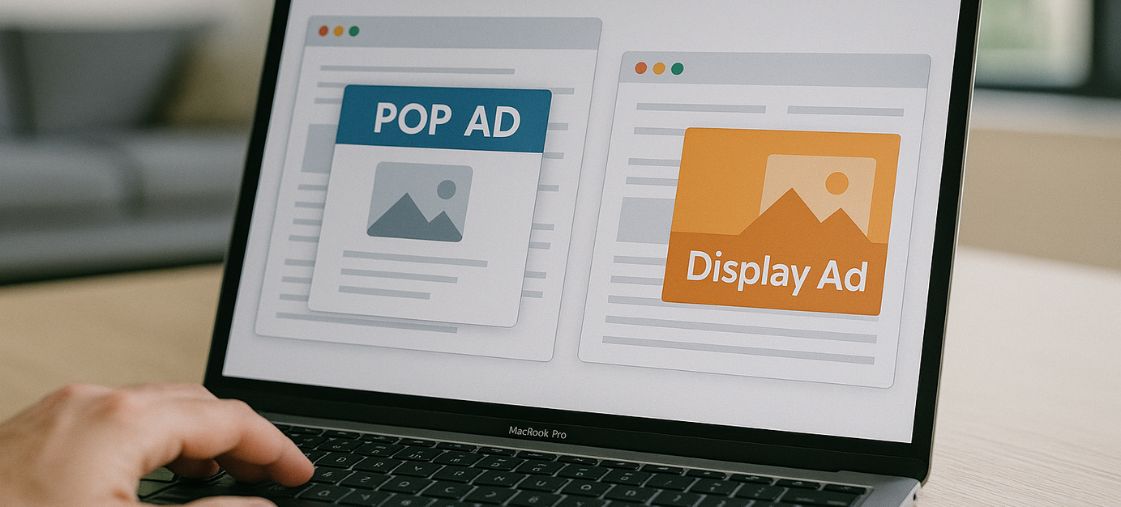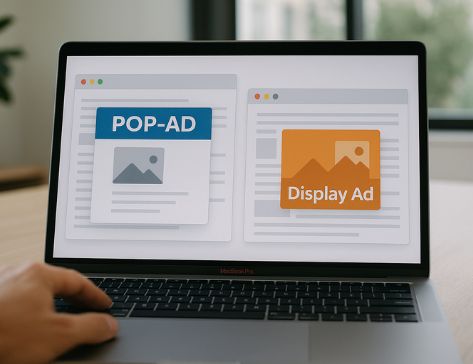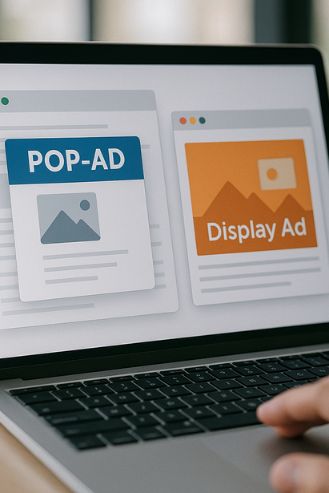
Pop Ads vs Display Ads: What Converts Better for Affiliate Marketers
Pop ads vs display ads is the question many affiliate marketers ask when chasing consistent conversions. Both formats can drive profit, yet they behave differently across funnels, geos, devices, and verticals. In this guide, we’ll compare conversion dynamics, targeting options, creative requirements, compliance risks, testing methodology, and when each ad type tends to win, so you can invest your budget with confidence.

Definitions: Pop ads and display ads
First, let’s define the formats. Pop ads (also called popunders or pops) open a new browser tab or window that immediately shows your landing page. Display ads are the banners and native-like boxes users see embedded on a webpage or app. If you want a quick refresher on the mechanics and pros/cons of each, this comparison of banner ads vs pop-up ads is a solid primer.
How conversions happen and why intent matters
What counts as a “conversion” in affiliate marketing? For some offers it’s a submit (SOI/DOI), for others a trial, install, deposit, or purchase. Because the conversion event shapes required intent and friction tolerance, the better format is the one that aligns the user’s context with your funnel’s ask. High-friction checkouts usually prefer warmer traffic; low-friction lead-gen can thrive on colder, cheaper reach.
Intent, context, and creative alignment
User intent and context. Pop traffic is interruption-based: you capture attention by appearing on top of the current session. That grants you unmatched reach and volume, but it also means you must earn engagement quickly with relevance, speed, and clarity. Display, by contrast, competes within a content feed; it tends to attract users who notice your message while doing something else. Modern AI ad spying tools can reveal which creatives and angles are currently winning across both formats, helping you bridge the intent gap.
Targeting precision and inventory realities
Targeting precision and inventory structure. Display networks usually offer more granular controls—placements, audiences, topics, interest cohorts, and tighter brand safety filters. Pop networks rely heavily on sources and zones, device and OS targeting, and frequency caps. The upshot: display often delivers cleaner brand-safe traffic with narrower reach; pops deliver raw scale with variability that you tame through aggressive whitelisting and optimization.
Creative and UX differences
Creative and user experience. Display ads live or die by the creative’s hook, clarity, and congruence with the landing page. Sizes matter (e.g., 300×250, 728×90, 160×600), and so do thumb-stopping visuals and copy. With pops, your lander is the ad. Page-load speed, hero headline, above-the-fold call to action, and device-fit are decisive. Prelanders can warm up users, but every extra second kills response, particularly on 3G/4G or congested Wi‑Fi.
Costs, bidding models, and ROI math
Costs, bidding, and ROI math. Pops usually sell on CPM or CPC at low rates; display varies from CPM to CPC and sometimes CPA on certain platforms. Don’t compare formats only on cost—compare on effective EPC and profitability. Two simple sanity checks: 1) Back into break-even CPM given your CTR, CVR, and payout; 2) Track ROI and payback period, not just day-one ROAS. Pops often win on fast testing cycles and cheap data; display can compound as you scale proven creatives onto quality inventory.
Vertical-by-vertical patterns
Vertical-by-vertical tendencies. Pops often shine for utilities (VPN, antivirus, cleaners), sweepstakes, push or SMS collectors, simple mobile content, and certain content arbitrage. Display tends to outperform for e‑commerce, subscription boxes, B2B lead gen, and higher AOV products where storytelling through creatives and retargeting matters. Gray-area niches may favor pops for reach but bring stricter compliance hurdles.
Geo, device, and carrier nuances
Geo, device, and carrier nuances. In Tier‑2/3 geos, pops can bring extraordinary volume at manageable CPMs, but quality varies by source. In Tier‑1 geos, display’s brand-safe placements and audience layers can keep conversion rates steadier, albeit at higher costs. On mobile, ensure your CTA is thumb-friendly, input fields are minimal, and checkout flows respect autofill and wallet options.
Funnel orchestration: Use both instead of either/or
Funnel orchestration and sequencing. Many top affiliates pair the two formats instead of choosing one. For example, they seed initial prospecting with pops to collect cheap leads or pixels, then use display retargeting and look‑alike expansion to close higher‑value actions. Others run display prospecting to warm audiences and follow up with pops for hard‑hitting time‑limited offers.
Optimization playbook
Optimization playbook. Whether you buy pops or display, the levers are similar: refine sources/placements; adjust dayparting; cap frequency; rotate creatives; test landers and prelanders; tighten geos, devices, and OS versions; and prune anything that drains EPC. For pops, build strict whitelists and block underperforming zones quickly. For display, isolate champion placements and expand with look‑alikes while keeping brand safety tight.
Compliance and user experience
Compliance and user experience risks. Pops can trigger browser-level blocks, anti-malware flags, or publisher pushback if abused. Always honor consent requirements, avoid misleading UX, and keep exit behavior clean. Display has its own pitfalls: disapproved creatives, policy-sensitive verticals, and accidental clicks from poor placements. A clean, honest experience reduces refunds, chargebacks, and negative feedback loops that quietly degrade traffic quality.
Measurement and testing methodology
Measurement and testing methodology. Set up end-to-end tracking with first-party data where possible. Use server-side postbacks for reliability, deduplicate events, and tag traffic by source, zone, placement, and creative ID. Run controlled A/B tests with adequate sample sizes—usually at least 200–300 conversions per variant for dependable reads in noisy environments. When budgets are tight, iterate quickly on small slices but freeze changes while measuring to avoid confounding.
Practical benchmarks for “what converts better”
Practical benchmarks for “what converts better”. There is no universal winner; there are patterns. If your offer is low-friction, impulse-friendly, or utility-driven, pops generally deliver faster results. If your offer needs education, visual proof, or brand trust, display tends to win—especially when you stack retargeting. The right answer is often “both, but in different jobs within the same funnel.”
Creative angles that win
Creative angles that win. For pops: device-cleaning alerts, limited-time discounts, geo-specific claims, and straightforward benefit headlines like “Speed up your phone in 2 minutes.” For display: before/after visuals, UGC-style creatives, social proof badges, and curiosity-led hooks. Always maintain message-match from ad to lander; mismatched promises are the fastest way to tank CVR.
KPIs to monitor daily
KPIs to monitor daily. CTR (for display), bounce rate on landers, time-to-first-interaction, CVR by source/placement, approved-to-paid conversion, and refund/chargeback ratios by geo. On pops, scrutinize zone-level EPC and isolate power sources; on display, identify high-viewability placements and auction dynamics that spike costs.
Conclusion: So, which converts better—pop ads or display ads?
Ultimately, pop ads vs display ads is not a binary choice but a portfolio decision. For cold, scalable reach at low testing costs, pops are hard to beat; for durable conversion rates on higher-intent audiences, display excels—especially when paired with retargeting and creative storytelling. If you’re exploring pops at scale, a competitive intelligence tool like Anstrex Pops can help you spot landing patterns, angles, and carriers that top affiliates are exploiting. Combine those insights with disciplined testing and you’ll know, in your niche, which format truly converts better.


